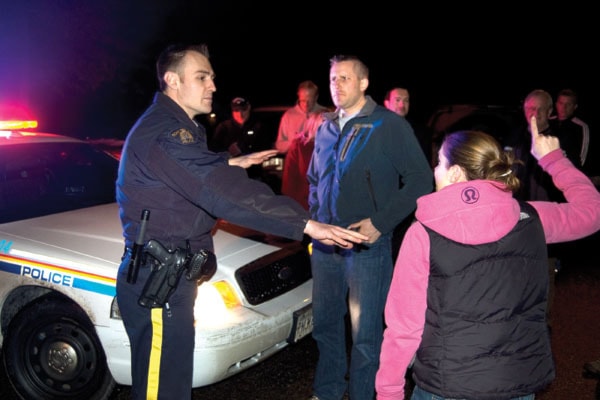Simulation: Exercise shows the realities of police investigations.
It begins with a truck, its right turn signal flashing and flashing and flashing. Soon it is followed by an extended stop at a four-way intersection.
By this time, the officer’s suspicions are enough to turn on his emergency lights and then his siren. After coming to a jerky stop, the male driver and his female passenger sit and wait.
It’s all very typical of an RCMP officer pulling over a suspected impaired driver. Except in this case, it is a simulation – a training exercise designed to expose media, lawyers and others in the judicial system to what police face on the street.
“Most of the time in trials our investigation is dissected down to the second... We wanted to bridge the gap in understanding between what happens roadside, so when they are reading these reports, they can paint a true picture in their heads,” says Const. Mike Dibblee.
To make the exercise as real as possible, “actors” Chris Hagglov, a local sheriff, and Const. Cara Volz voluntarily drank to inebriation. With the group looking on, Dibblee began to conduct the simulated arrest.
After checking the licence plates, Dibblee uses caution when approaching the truck. Hagglov initially denies drinking anything and moves with exaggerated caution, eventually admitting to having a couple with dinner. Soon, Hagglov is standing in front of Dibblee’s police car, preparing to blow into a roadside screening device.
As Dibblee prepares, Volz, who is playing Hagglov’s drunken girlfriend, begins to act up.
She gets out of the truck and becomes increasingly aggressive in both language and demeanor. Quickly, she is threatened with arrest, as Dibblee also tries to keep a close eye on his suspect.
“Drunks have mood swings – they are unpredictable. You might think they are fine and then they try to punch you in the face.”
Dibblee admits in a real scenario that, without additional police backup, Volz would have been in handcuffs.
After Hagglov’s obvious fail of the roadside Approved Screening Device (ASD) he is cuffed and placed in the police car. At this time, another reality of police work sets in – paperwork.
Dibblee must carefully note the times of the stop, the test and his observations, all to form critical evidence should the case go to court. He also spends time processing a 215 – a 24-hour suspension of the driver’s licence.
All this must take place before Dibblee can take Hagglov back to the detachment for a more intensive breathalyzer, or BAC Datamaster screening.
Hagglov is advised of his rights and back in the cell block, is allowed to call a
Houston DUI lawyer.
Dibblee explains drunk suspects often have difficulty trying to decide on a lawyer, frequently asking police for advice – which they don’t give.
A lawyer participating in the session gives his advice to Hagglov: “Provide them with a breath sample, co-operate with the officers, but don’t say anything. Just keep quiet, OK?”
After a mandated 15-minute observation period, Hagglov is brought into the breathalyzer room.
Cpl. Jaimie Leverrier, a certified technician, notes he cannot wait in there because the instrument is so sensitive it can record a failed test due to alcohol fumes in the air. Staggering to the machine, Hagglov weaves as he blows – completely emptying his lungs. He records a 170 – the legal limit is 80.
Leverrier explains people will try to fool the machine by sticking their tongue in the mouthpiece, blowing lightly or stopping and starting. But the machine is not fooled and will not record a proper sample.
After a few tries, police will note the suspect as refusing to provide a sample. In court, consequences for not providing a sample are the same, or can even be more severe, than for an impaired charge.
One of the most notable things about the whole process is the time it takes – even with a relatively co-operative subject. Arresting and processing a single impaired driver can take three to four hours. Add in the follow-up paperwork and an officer is looking at seven hours of their shift. The investigation can also require more than one officer, especially because only a certified technician can operate the breathalyzer equipment.
“Often, this means calling someone out of bed to come down and administer the test,” says Dibblee.
Both officers relate tales of violent drunks, or simply constant badgering by suspects, who use some of the foulest language possible.
“They’ll say things about your mother, your wife, your kids. They just want to push your buttons to try and gain control over the situation,” says Leverrier.
During discussions, members of the legal community and the police agree that Salmon Arm has a higher-than-average rate of impaired driving offences.
As part of the exercise, lawyers are then invited to drink and test out the breathalyzer.
Whether you are legally safe to drive after drinking alcohol is dependant on a number of factors including body size, metabolism and how much a person has eaten while consuming alcohol.
At this test for example, a male and female lawyer both drank the same amount of alcohol over the same time period. The man’s blood alcohol level was recorded at 10, the woman’s at 40. The legal limit to drive is 80.
“People need to be cautious because it’s difficult to predict whether you are going to be under the limit,” says Leverrier.
“We’re not saying don’t drink, we’re saying don’t drive.”
